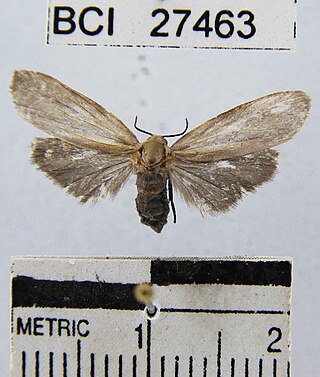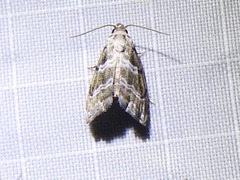Apeplopoda is a genus of tiger moths in the family Erebidae. The genus was erected by Watson in 1980.
Aphra is a genus of moths in the subfamily Arctiinae. The genus was described by Watson in 1980.
Apogurea is a monotypic moth genus in the subfamily Arctiinae erected by Watson, Fletcher and Nye in 1980. Its single species, Apogurea grisescens, was first described by Franz Daniel in 1951. It is found in Zhejiang, China.

Chiretolpis is a genus of moths in the family Erebidae.
Dipaenae is a genus of moths in the subfamily Arctiinae. The genus was erected by Francis Walker in 1854.

Euthyone is a genus of moths in the subfamily Arctiinae. The genus was erected by Watson, Fletcher and Nye in 1980.
Hobapromea is a monotypic moth genus in the subfamily Arctiinae described by Watson in 1980. Its single species, Hobapromea cleta, was first described by Turner in 1940. It is found in Queensland, Australia.

Abablemma is a genus of moths in the family Erebidae. The genus was described by Nye in 1910.
Gloanna is a genus of moths of the family Noctuidae. The genus was described by Nye in 1975.
Hapda is a monotypic moth genus of the family Erebidae described by Nye in 1975. It was first described by Francis Walker in 1863 as Dapha. Its only species, Hapda exhibens, was described by Walker in 1863.
Gissarus is a monotypic moth genus in the subfamily Lymantriinae described by Nye in 1980. Its only species, Gissarus relictus, was first described by Igor Vasilii Kozhanchikov in 1950. It is found in Tajikistan.
Halseyella is a monotypic moth genus in the subfamily Lymantriinae described by Nye in 1980. Its only species, Halseyella flavicollis, was first described by John Henry Leech in 1890. It is found in the Chinese province of Hubei.

Jacksoniana is a monotypic moth genus in the subfamily Lymantriinae described by Nye in 1980. Its only species, Jacksoniana striata, was first described by Cyril Leslie Collenette in 1937.
Kunusara is a monotypic moth genus in the subfamily Lymantriinae described by Nye in 1980. Its only species, Kunusara fontainei, was first described by Cyril Leslie Collenette in 1960. It is found in the Congo Basin.
Melgona is a monotypic moth genus in the subfamily Lymantriinae described by Nye in 1980. Its only species, Melgona conia, was first described by Cyril Leslie Collenette in 1956. It is found in Kenya, where it was described from Mount Elgon.
Noliproctis is a monotypic moth genus in the subfamily Lymantriinae described by Hering in 1926. Its only species, Noliproctis milupa, was first described by Nye in 1980. It is found on Madagascar.
Axiagasta stactogramma is the only species in the monotypic moth genus Axiagasta of the family Tineidae. It is found in Brazil. The genus name is a junior homonym that has apparently never been replaced.

Monodonta is a genus of moths of the family Crambidae. It contains only one species, Monodonta passalis, which is described from Mount Kebea in New Guinea. The genus name is a junior homonym of Monodonta Lamarck, 1799 but no replacement name is currently available.
Phiditia is a genus of moths of the family Phiditiidae erected by Heinrich Benno Möschler in 1883.



